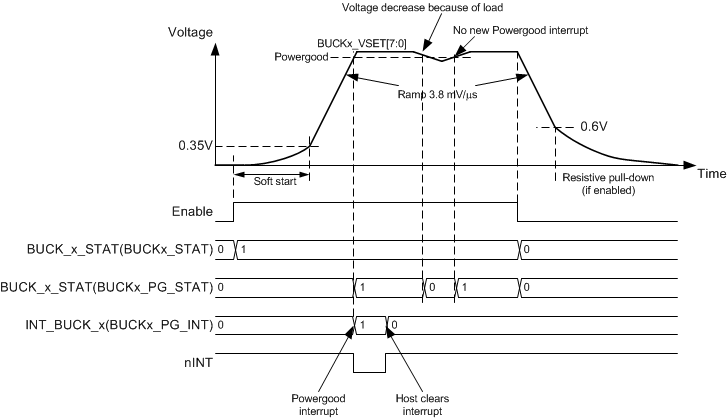ZHCSH29B April 2017 – December 2018 LP87524B-Q1 , LP87524J-Q1 , LP87524P-Q1
PRODUCTION DATA.
- 1 特性
- 2 应用
- 3 说明
- 4 修订历史记录
- 5 Pin Configuration and Functions
- 6 Specifications
-
7 Detailed Description
- 7.1 Overview
- 7.2 Functional Block Diagram
- 7.3
Feature Descriptions
- 7.3.1 DC-DC Converters
- 7.3.2 Sync Clock Functionality
- 7.3.3 Power-Up
- 7.3.4 Regulator Control
- 7.3.5 Enable and Disable Sequences
- 7.3.6 Device Reset Scenarios
- 7.3.7 Diagnosis and Protection Features
- 7.3.8 GPIO Signal Operation
- 7.3.9 Digital Signal Filtering
- 7.4 Device Functional Modes
- 7.5 Programming
- 7.6
Register Maps
- 7.6.1
Register Descriptions
- 7.6.1.1 OTP_REV
- 7.6.1.2 BUCK0_CTRL1
- 7.6.1.3 BUCK1_CTRL1
- 7.6.1.4 BUCK2_CTRL1
- 7.6.1.5 BUCK3_CTRL1
- 7.6.1.6 BUCK0_VOUT
- 7.6.1.7 BUCK0_FLOOR_VOUT
- 7.6.1.8 BUCK1_VOUT
- 7.6.1.9 BUCK1_FLOOR_VOUT
- 7.6.1.10 BUCK2_VOUT
- 7.6.1.11 BUCK2_FLOOR_VOUT
- 7.6.1.12 BUCK3_VOUT
- 7.6.1.13 BUCK3_FLOOR_VOUT
- 7.6.1.14 BUCK0_DELAY
- 7.6.1.15 BUCK1_DELAY
- 7.6.1.16 BUCK2_DELAY
- 7.6.1.17 BUCK3_DELAY
- 7.6.1.18 GPIO2_DELAY
- 7.6.1.19 GPIO3_DELAY
- 7.6.1.20 RESET
- 7.6.1.21 CONFIG
- 7.6.1.22 INT_TOP1
- 7.6.1.23 INT_TOP2
- 7.6.1.24 INT_BUCK_0_1
- 7.6.1.25 INT_BUCK_2_3
- 7.6.1.26 TOP_STAT
- 7.6.1.27 BUCK_0_1_STAT
- 7.6.1.28 BUCK_2_3_STAT
- 7.6.1.29 TOP_MASK1
- 7.6.1.30 TOP_MASK2
- 7.6.1.31 BUCK_0_1_MASK
- 7.6.1.32 BUCK_2_3_MASK
- 7.6.1.33 SEL_I_LOAD
- 7.6.1.34 I_LOAD_2
- 7.6.1.35 I_LOAD_1
- 7.6.1.36 PGOOD_CTRL1
- 7.6.1.37 PGOOD_CTRL2
- 7.6.1.38 PGOOD_FLT
- 7.6.1.39 PLL_CTRL
- 7.6.1.40 PIN_FUNCTION
- 7.6.1.41 GPIO_CONFIG
- 7.6.1.42 GPIO_IN
- 7.6.1.43 GPIO_OUT
- 7.6.1
Register Descriptions
- 8 Application and Implementation
- 9 Power Supply Recommendations
- 10Layout
- 11器件和文档支持
- 12机械、封装和可订购信息
7.3.4.1 Enabling and Disabling Regulators
The regulator(s) can be enabled when the device is in STANDBY or ACTIVE state. There are two ways for enable and disable the regulators:
- Using EN_BUCKx bit in BUCKx_CTRL1 register (EN_PIN_CTRLx register bit is 0)
- Using EN1/2/3 control pins (EN_BUCKx bit is 1 AND EN_PIN_CTRLx register bit is 1 in BUCKx_CTRL1 register)
If the EN1/2/3 control pins are used for enable and disable then the control pin is selected with BUCKx_EN_PIN_SELECT[1:0] bits (in BUCKx_CTRL1 register). The delay from the control signal rising edge to enabling of the regulator is set by BUCKx_STARTUP_DELAY[3:0] bits and the delay from control signal falling edge to disabling of the regulator is set by BUCKx_SHUTDOWN_DELAY[3:0] bits in BUCKx_DELAY register. The delays are valid only for EN1/2/3 signal control. The control with EN_BUCKx bit is immediate without the delays.
The control of the regulator (with 0-ms delays) is shown in Table 3.
NOTE
The control of the regulator cannot be changed from one ENx pin to a different ENx pin because the control is ENx signal edge sensitive. The control from ENx pin to register bit and back to the original ENx pin can be done during operation.
Table 3. Regulator Control
| CONTROL METHOD | EN_BUCKx | EN_PIN_CTRLx | BUCKx_EN_PIN_SELECT[1:0] | EN_ROOF_FLOOR x | EN1 PIN | EN2 PIN | EN3 PIN | BUCKx
OUTPUT VOLTAGE |
|---|---|---|---|---|---|---|---|---|
| Enable/disable control with EN_BUCKx bit | 0 | Don't Care | Don't Care | Don't Care | Don't Care | Don't Care | Don't Care | Disabled |
| 1 | 0 | Don't Care | Don't Care | Don't Care | Don't Care | Don't Care | BUCKx_VSET[7:0] | |
| Enable/disable control with EN1 pin | 1 | 1 | 00 | 0 | Low | Don't Care | Don't Care | Disabled |
| 1 | 1 | 00 | 0 | High | Don't Care | Don't Care | BUCKx_VSET[7:0] | |
| Enable/disable control with EN2 pin | 1 | 1 | 01 | 0 | Don't Care | Low | Don't Care | Disabled |
| 1 | 1 | 01 | 0 | Don't Care | High | Don't Care | BUCKx_VSET[7:0] | |
| Enable/disable control with EN3 pin | 1 | 1 | 10 | 0 | Don't Care | Don't Care | Low | Disabled |
| 1 | 1 | 10 | 0 | Don't Care | Don't Care | High | BUCKx_VSET[7:0] | |
| Roof/floor control with EN1 pin | 1 | 1 | 00 | 1 | Low | Don't Care | Don't Care | BUCKx_FLOOR_VSET[7:0] |
| 1 | 1 | 00 | 1 | High | Don't Care | Don't Care | BUCKx_VSET[7:0] | |
| Roof/floor control with EN2 pin | 1 | 1 | 01 | 1 | Don't Care | Low | Don't Care | BUCKx_FLOOR_VSET[7:0] |
| 1 | 1 | 01 | 1 | Don't Care | High | Don't Care | BUCKx_VSET[7:0] | |
| Roof/floor control with EN3 pin | 1 | 1 | 10 | 1 | Don't Care | Don't Care | Low | BUCKx_FLOOR_VSET[7:0] |
| 1 | 1 | 10 | 1 | Don't Care | Don't Care | High | BUCKx_VSET[7:0] |
The regulator is enabled by the ENx pin or by I2C writing as shown in Figure 8. The soft-start circuit limits the in-rush current during start-up. When the output voltage rises to 0.35-V level, the output voltage becomes slew-rate controlled. If there is a short circuit at the output and the output voltage does not increase above 0.35-V level in 1 ms, the regulator is disabled, and interrupt is set. When the output voltage reaches the Power-Good threshold level the BUCKx_PG_INT interrupt flag (in INT_BUCK_x register) is set. The Power-Good interrupt flag can be masked using BUCKx_PG_MASK bit (in BUCKx_MASK register).
The ENx input pins have integrated pulldown resistors. The pulldown resistors are enabled by default, and the host can disable those with ENx_PD bits (in CONFIG register).
 Figure 8. Regulator Enable and Disable
Figure 8. Regulator Enable and Disable